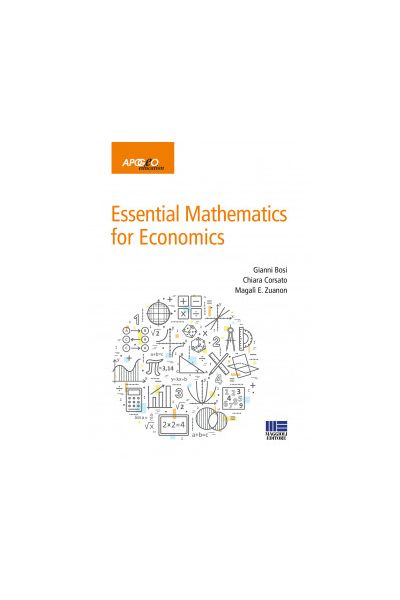ESSENTIAL MATHEMATICS FOR ECONOMICS
Regular Price
26,00 €
Special Price
24,70 €

Spesa minima per la spedizione gratuita: 60,00 €
NOTA: Valido solo per spedizioni in Italia
Tipologia Libri
Autore: Bosi Gianni, Corsato Chiara, Zuanon Magalì
Editore MAGGIOLI
Collana APOGEO
Pagine 262
Data pubblicazione 15 set 2018
Argomento: Economia generale
SKU/ISBN: 9788891629883
This short book is aimed at undergraduate students with a very standard knowledge of algebra learnt at the high school, and it appears as “self contained”.
According to the long teaching experience of the authors, it was written in order to furnish nearly all the material both for a 90-hour course of “Mathematics for Economics”, and for a 45-hour course of “Financial Mathematics”.
The book is the result of a thoughtful selection of the arguments, and of the calibration of the difficulty, in order to allow all students to pass the exam with a sufficiently large knowledge of the material, and at the same time to give to the best students the opportunity to detect stimulating occasions for further personal investigation.
Chapter 1 - Some elements of logic and set theory
1.1 Some elements of logic
1.2 Set Theory
1.3 Exercises
Chapter 2 - Mappings and relations
2.1 Mappings
2.2 Binary relations
2.3 Order relations
2.4 Exercises
Chapter 3 - Combinatorics
3.1 Dispositions without repetitions and permutations
3.2 Combinations
3.3 Dispositions with repetitions
3.4 Exercises
Chapter 4 - Real numbers
4.1 Fromnatural to realnumbers
4.2 Quadratic equations and quadratic inequalities
4.3 Basic topological concepts in R
4.4 Exercices
Chapter 5 - Real-valued functions of one real variable
5.1 General concepts
5.2 Trigonometric functions and their inverses
5.3 Exercises
Chapter 6 - Continuous functions
6.1 Definition and first properties
6.2 Theorems on continuity
6.3 Exercises
Chapter 7 - Limits
7.1 Finite limits
7.2 Infinite limits and limits as x approaches infinity
7.3 Theorems on limits
7.4 Limits with the trigonometric functions
7.5 Exercises
Chapter 8 - Exponential and logarithmic functions
8.1 Powers with real exponents
8.2 Exponential and logarithmic functions
8.3 Limits with exponential and logarithmic functions
8.4 Exercises
Chapter 9 - Differential calculus
9.1 The concept of derivative
9.2 Important derivatives
9.3 Theorems on differentiation
9.4 Local properties of the first degree
9.5 Theorems on differentiable functions on intervals
9.6 Local approximation by means of polynomials
9.7 Local convexity and concavity
9.8 Exercises
Chapter 10 - Integral calculus
10.1 Indefinite integral
10.2 Definite integral
10.3 Exercises
Chapter 11 - Matrix algebra and the structure of Rn
11.1 Basic definitions
11.2 The algebraic and topological structure of Rn
11.3 Exercises
Chapter 12 - Real functions of many real variables
12.1 General concepts
12.2 Quadratic forms
12.3 Partial derivatives and optimization
12.4 Exercises
Chapter 13 - Basic concepts of financial mathematics
13.1 Classical financial regimes
13.2 The regime of compound interest
13.3 Exercises
Chapter 14 - Annuities and debt amortization
14.1 Annuities and perpetuities
14.2 Amortization of a debt
14.3 Negotiation of a debt: Makeham formula
14.4 Exercises
Chapter 15 - Solution to selected Exercises
According to the long teaching experience of the authors, it was written in order to furnish nearly all the material both for a 90-hour course of “Mathematics for Economics”, and for a 45-hour course of “Financial Mathematics”.
The book is the result of a thoughtful selection of the arguments, and of the calibration of the difficulty, in order to allow all students to pass the exam with a sufficiently large knowledge of the material, and at the same time to give to the best students the opportunity to detect stimulating occasions for further personal investigation.
Chapter 1 - Some elements of logic and set theory
1.1 Some elements of logic
1.2 Set Theory
1.3 Exercises
Chapter 2 - Mappings and relations
2.1 Mappings
2.2 Binary relations
2.3 Order relations
2.4 Exercises
Chapter 3 - Combinatorics
3.1 Dispositions without repetitions and permutations
3.2 Combinations
3.3 Dispositions with repetitions
3.4 Exercises
Chapter 4 - Real numbers
4.1 Fromnatural to realnumbers
4.2 Quadratic equations and quadratic inequalities
4.3 Basic topological concepts in R
4.4 Exercices
Chapter 5 - Real-valued functions of one real variable
5.1 General concepts
5.2 Trigonometric functions and their inverses
5.3 Exercises
Chapter 6 - Continuous functions
6.1 Definition and first properties
6.2 Theorems on continuity
6.3 Exercises
Chapter 7 - Limits
7.1 Finite limits
7.2 Infinite limits and limits as x approaches infinity
7.3 Theorems on limits
7.4 Limits with the trigonometric functions
7.5 Exercises
Chapter 8 - Exponential and logarithmic functions
8.1 Powers with real exponents
8.2 Exponential and logarithmic functions
8.3 Limits with exponential and logarithmic functions
8.4 Exercises
Chapter 9 - Differential calculus
9.1 The concept of derivative
9.2 Important derivatives
9.3 Theorems on differentiation
9.4 Local properties of the first degree
9.5 Theorems on differentiable functions on intervals
9.6 Local approximation by means of polynomials
9.7 Local convexity and concavity
9.8 Exercises
Chapter 10 - Integral calculus
10.1 Indefinite integral
10.2 Definite integral
10.3 Exercises
Chapter 11 - Matrix algebra and the structure of Rn
11.1 Basic definitions
11.2 The algebraic and topological structure of Rn
11.3 Exercises
Chapter 12 - Real functions of many real variables
12.1 General concepts
12.2 Quadratic forms
12.3 Partial derivatives and optimization
12.4 Exercises
Chapter 13 - Basic concepts of financial mathematics
13.1 Classical financial regimes
13.2 The regime of compound interest
13.3 Exercises
Chapter 14 - Annuities and debt amortization
14.1 Annuities and perpetuities
14.2 Amortization of a debt
14.3 Negotiation of a debt: Makeham formula
14.4 Exercises
Chapter 15 - Solution to selected Exercises
Scrivi la tua recensione


